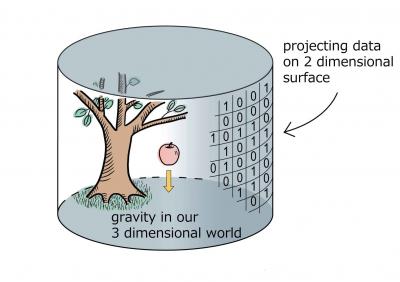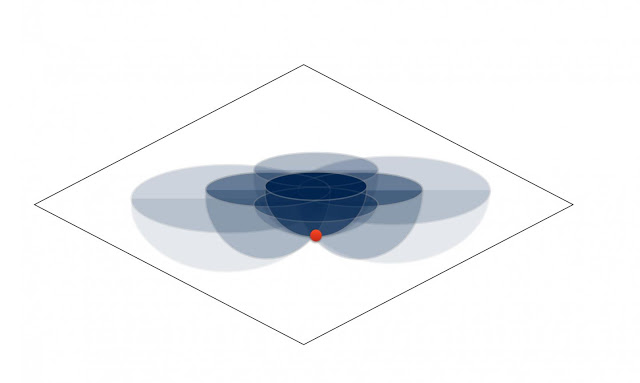| Online: | |
| Visits: | |
| Stories: |

| Story Views | |
| Now: | |
| Last Hour: | |
| Last 24 Hours: | |
| Total: | |
How Spacetime Is Built by Quantum Entanglement
Physicists and mathematicians have long sought a Theory of Everything (ToE) that unifies general relativity and quantum mechanics. General relativity explains gravity and large-scale phenomena such as the dynamics of stars and galaxies in the universe, while quantum mechanics explains microscopic phenomena from the subatomic to molecular scales.
The mathematical formula derived by Ooguri and his collaborators relates local data in the extra dimensions of the gravitational theory, depicted by the red point, are expressed in terms of quantum entanglements, depicted by the blue domes.
Now, Ooguri and his collaborators have found that quantum entanglement is the key to solving this question. Using a quantum theory (that does not include gravity), they showed how to compute energy density, which is a source of gravitational interactions in three dimensions, using quantum entanglement data on the surface. This is analogous to diagnosing conditions inside of your body by looking at X-ray images on two-dimensional sheets. This allowed them to interpret universal properties of quantum entanglement as conditions on the energy density that should be satisfied by any consistent quantum theory of gravity, without actually explicitly including gravity in the theory. The importance of quantum entanglement has been suggested before, but its precise role in emergence of spacetime was not clear until the new paper by Ooguri and collaborators.
Quantum entanglement is a phenomenon whereby quantum states such as spin or polarization of particles at different locations cannot be described independently. Measuring (and hence acting on) one particle must also act on the other, something that Einstein called “spooky action at distance.” The work of Ooguri and collaborators shows that this quantum entanglement generates the extra dimensions of the gravitational theory.
“It was known that quantum entanglement is related to deep issues in the unification of general relativity and quantum mechanics, such as the black hole information paradox and the firewall paradox,” says Hirosi Ooguri. “Our paper sheds new light on the relation between quantum entanglement and the microscopic structure of spacetime by explicit calculations. The interface between quantum gravity and information science is becoming increasingly important for both fields. I myself am collaborating with information scientists to pursue this line of research further.”
Contacts and sources:
Motoko Kakubayashi
Hirosi Ooguri, Principal Investigator
Kavli Institute for the Physics and Mathematics of the Universe, The University of Tokyo
Project Specialist
Kavli Institute for the Physics and Mathematics of the Universe, The University of Tokyo
Kavli Institute for the Physics and Mathematics of the Universe http://www.ipmu.jp/
Citation: ”Locality of Gravitational Systems from Entanglement of Conformal Field Theories” Journal: Physical Review Letters
Authors: Jennifer Lin (1), Matilde Marcolli (2), Hirosi Ooguri (3,4), Bogdan Stoica (3)
Author affiliations: (1) Enrico Fermi Institute and Department of Physics, University of Chicago
(2) Department of Mathematics, California Institute of Technology
(3) Walter Burke Institute for Theoretical Physics, California Institute of Technology
(4) Kavli Institute for the Physics and Mathematics of the Universe (WPI), University of Tokyo
Source: http://www.ineffableisland.com/2015/05/how-spacetime-is-built-by-quantum.html





